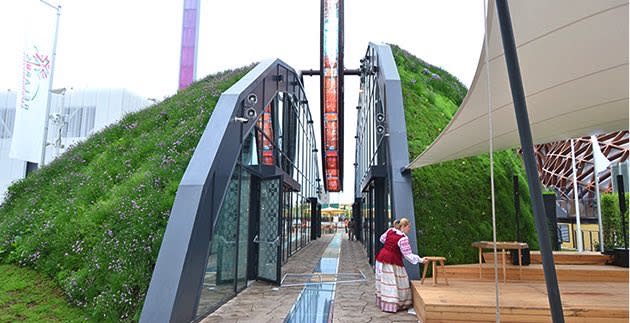Inhabitat's Week in Green: Concept kitchens and Google's crabots

Each week our friends at Inhabitat recap the week's most interesting green developments and clean tech news for us -- it's the Week in Green.
Hardly a week passes when Tesla doesn't make the news, and this past week the company had two big announcements that are getting people all riled up. First, Tesla is planning to debut a $35,000 electric car in March 2016 that will begin production in 2017. CEO Elon Musk also just announced that barely a week after the Powerwall home battery was unveiled, they're already sold out through 2016, and the company will have to expand its factory capabilities to meet the insane demand for batteries.
In other green transportation developments, the Solar Impulse airplane is about to embark on a five-day flight across the Pacific Ocean, beginning in China and ending in Hawaii. We also took a sneak peek at New York City's train station of the future as Santiago Calatrava's epic Oculus World Trade Center Transportation Hub opened for the first time.
NASA's Earth Science program is the gold standard for studying our planet, providing valuable data on the climate collected from orbiting satellites. But House Republicans are pushing a bill that would slash funding to the program by up to $500 million. If we're going to slow climate change, renewable energy is going to play a key role. Last week, Bill Clinton toured a Solar Sister site in Tanzania, which is providing microfinancing to women to help them sell solar-powered lanterns and cookstoves. And the next generation of wind turbines may not have blades at all. The Vortex looks like a gigantic straw, and it oscillates in the wind to generate energy without harming birds and bats.
Refrigerators are such a fixture in kitchens across the world, it's hard to imagine life without them -- but that's exactly what IKEA is doing. In its Concept Kitchen 2025, IKEA suggested that a decade from now, the fridge could be replaced by a "modern pantry" that uses smart tech to keep fruits and veggies cool. And more than 200 leading scientists have confirmed what many already suspected: Nonstick pans are bad for us. The chemicals used in nonstick pans have been connected to liver toxicity and immune and endocrine disorders. We kicked off New York Design Week by reporting live from BKLYN Designs, where designers showcased the future of low-energy lighting. Urban Chandy gave energy-sucking incandescents a run for their money by launching a line of Edison bulb-inspired LED fixtures, and Dyad wowed us with its ultra-modern LED light tubes.
Google is planning to expand its Silicon Valley headquarters, and new documents reveal that the tech giant plans to use crab-shaped robots, or "crabots," to construct the new buildings. Regardless of how Google plans to build the project, it sounds like the company will have to scale back its ambitions. Mountain View's city council has granted the company just a fraction of the land it originally requested. In other architecture news, the 2015 Milan World Expo just kicked off, and it's a showcase of architectural innovations with an emphasis the future of sustainable agriculture. The American Food 2.0 pavilion features a 7,200-square-foot vertical farm, which is packed with 42 varieties of veggies, grains and herbs. The Republic of Belarus built a building that's shaped like a grassy hillside with a large wooden wheel situated above it to symbolize the importance of biodiversity. The Austrian pavilion is a multi-sensory experience featuring a small urban forest that produces enough oxygen for 1,800 people in just an hour. The Vanke Pavilion, which was designed by Daniel Libeskind, is clad in red tiles that suck pollution from the air.


